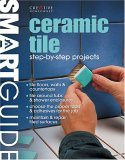A Ceramic Tile Basement Floor is a Natural and Low Maintenance Basement Flooring Option
By Mark J. Donovan
|
|
Tiling a basement floor is easy to do and has a number of advantages over other basement flooring options. First and foremost, a ceramic tiled basement floor is less sensitive to moisture concerns than carpet or wood floor products. Cleaning and maintaining a ceramic tile floor is also much easier to do than with a carpeted or wood floor.
Tiling a basement floor starts with a spotlessly clean basement floor. Any protrusions on the basement floor surface should be removed. In addition, seal the basement floor with a sealer and allow it to fully dry before proceeding on with the installation of the ceramic floor tiles. |
When it comes to tile selection, I find using larger ceramic floor tiles, such as 12”x12” work best in larger areas such as a basement.
Prepping the Basement Floor
The first major step in tiling a basement floor is to find the center of the room and to mark its location on the basement floor. Then use a chalk line to establish two orthogonal lines on the basement floor that are coincident with the marks you made on the basement floor. If you are tiling a larger area of the basement you may want to snap additional chalk lines on the floor to create a grid pattern. The lines will help to ensure that the tiles are installed squarely as you place the basement floor tiles.
Make sure when placing the ceramic tile into position you push it firmly into the thinset mortar bed and lightly twist it back and forth once or twice to ensure a good bond with the mortar bed.
Continue to install the remaining tiles in this method, working your way from the center of the basement floor outwards. As you near the wall edges, cut the ceramic tiles to size using a wet saw or a tile cutter.
| With large tiles I find it best to maintain 1/8 to ¼ inch wide spacing in between tiles. To ensure even spacing use plastic tile spacers.
Grouting Tiled Basement Floor After the tiled basement floor has set up over a 24 hour period you can then grout the tile. First remove the tile spacers using a pair of pliers. Then mix grout in a large pale per the manufacturer’s directions and to the same consistency as the thinset mortar. |
 |
Apply the grout to the basement floor tiles using a rubber grout float. Slide the grout float over the ceramic tiles at a 45 degree angle to more efficiently apply the grout into the tile seams.
| Once you have applied grout to 9 to 12 square feet of area, use a damp wet sponge to clean off the surface areas of the ceramic tiles. Make sure to repeatedly rinse the wet sponge in a large clean bucket of water as your remove the grout residue from the surface of the basement floor tiles.
After you have grouted the entire basement floor, or after about 15 minutes have passed, whichever is sooner, go back with your bucket of clean water and sponge and make another pass cleaning the surface of the basement floor tiles. |
|
Again, after another 15-20 minutes or so have passed go back and clean the basement floor tiles again for a 3rd time with a bucket of clean water and sponge.
Then allow the grout to fully setup for 24 hours and then go back one last time and wipe the basement floor tiles down with a damp rag or sponge.
Finally, seal the tiles with a tile sealer to wrap up tiling your basement floor project.
See My Shower Pan Installation Ebook to Learn How to Install a Mortar Shower Pan: For a detailed set of instructions on building a shower pan, including pictures and a detailed cross-sectional view of the make-up of a shower pan, see my “Shower Pan Membrane Liner Ebook”.
Related Information
- Ceramic Tile Calculator for Estimating Tile Quantity and Costs
- Other Basement Flooring Options
- Tips on Installing a Bathroom in your Basement
Additional Ceramic Tile Resources from Amazon.com
 |
 |
 |
Get Free Basement Remodeling Price Quotes with No Obligation!
Fill out our 3-5 minute quick and easy form, and receive a free price quote on basement remodeling from one of our prescreened and licensed basement remodeling contractors. This process is free and there is no obligation to continue once you receive your basement remodeling price estimate.

